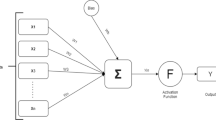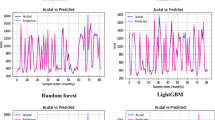Abstract
One construction method for employee training program evaluation system of three exponential forecast based on sliding window has been proposed to improve the effectiveness of construction process for employee training program evaluation system. Firstly, construct employee training program evaluation forecast model with gray model and set up regression forecast objective function; secondly, construct sliding window by setting segmentation points and make real-time segmentation for gray model data by combining three smoothness exponential algorithm, attain real-time statistical feature of data, construct the function relation between sequence error forecast and compression ratio, make use of error forecast sequence to make segmentation point judgment and improve robustness of test. Lastly, the effectiveness of the algorithm has been verified through simulation experiment.



Similar content being viewed by others
References
Geva, T., Zahavi, J.: Empirical evaluation of an automated intraday stock recommendation system incorporating both market data and textual news. Decis. Support Syst. 57(3), 212–223 (2014)
Yang, J., Zhao, C., Li, X., et al.: The reliability evaluation of electromagnetic valve of EMUs based on two-parameter exponential distribution. Open Mech Eng J 9(1), 630–636 (2015)
Ghareeb, N.H., Dayem, R.N.: Evaluation of the influence of three types of light curing systems on temperature rise, depth of cure and degree of conversion of three resin based composites (an in vitro study). Jbr J. Interdiscip. Med. Dent. Sci. 2, 110
Glasner, C., Volkert, J.: A three-phase adaptive prediction system of the run-time of jobs based on user behaviour. In: International Conference on Complex, Intelligent and Software Intensive Systems, pp. 886–891. IEEE, (2009)
Ramos, S., Soares, J., Vale, Z., et al.: Short-term load forecasting based on load profiling. In: Power and Energy Society General Meeting, pp. 1–5. IEEE (2013)
Clarke, L.P, Qian, W., Li, L.: Computer-assisted method and apparatus for analysis of x-ray images using wavelet transforms: US, US 5799100 A[P] (1998)
Kruijf, M.A.D., Sankaralingam, K., Jha, S.: Static analysis and compiler design for idempotent processing. In: Acm Sigplan Conference on Programming Language Design & Implementation, pp. 475–486. ACM (2012)
Giannakopoulos, G., Vouros, G., Vouros, G., et al.: Summarization system evaluation revisited: N-gram graphs. Acm Trans. Speech Lang. Process. 5(3), 5 (2008)
Erdogmus, D., Principe, J.C.: From linear adaptive filtering to nonlinear information processing—the design and analysis of information processing systems. Signal Process. Mag. IEEE 23(6), 14–33 (2006)
Dobber, M., Mei, R.V.D., Koole, G.: A prediction method for job runtimes on shared processors: survey, statistical analysis and new avenues. Perform. Eval. 64(7), 755–781 (2007)
Hamza, R., Muhammad, K., Arunkumar, N., González, G.R.: Hash based encryption for keyframes of diagnostic hysteroscopy. IEEE Access (2017). https://doi.org/10.1109/ACCESS.2017.2762405
Fernandes, S.L., Gurupur, V.P., Sunder, N.R., Arunkumar, N., Kadry, S.: A novel nonintrusive decision support approach for heart rate measurement. Pattern Recognit. Lett. (2017). https://doi.org/10.1016/j.patrec.2017.07.002
Malarkodi, M.P., Arunkumar, N., Venkataraman, V.: Gabor wavelet based approach for face recognition. Int. J. Appl. Eng. Res. 8(15), 1831–1840 (2013)
Hamza, R., Muhammad, K., Arunkumar, N., González, G.R.: Hash based encryption for keyframes of diagnostic hysteroscopy. IEEE Access (2017). https://doi.org/10.1109/ACCESS.2017.2762405
Arunkumar, N., Balaji, V.S., Ramesh, S., Natarajan, S., Likhita, V.R., Sundari, S.: Automatic detection of epileptic seizures using independent component analysis algorithm. In: IEEE-International Conference on Advances in Engineering, Science and Management, ICAESM, pp. 542–544. IEEE (2012)
Arunkumar, N., Mohamed Sirajudeen, K.M.: Approximate entropy based ayurvedic pulse diagnosis for diabetics—a case study. In: TISC 2011—Proceedings of the 3rd International Conference on Trendz in Information Sciences and Computing, pp. 133–135. TISC (2011)
Author information
Authors and Affiliations
Corresponding author
Rights and permissions
About this article
Cite this article
Meng, G. Construction of employee training program evaluation system of three exponential forecast based on sliding window. Cluster Comput 22 (Suppl 2), 4665–4671 (2019). https://doi.org/10.1007/s10586-018-2252-6
Received:
Revised:
Accepted:
Published:
Issue Date:
DOI: https://doi.org/10.1007/s10586-018-2252-6




